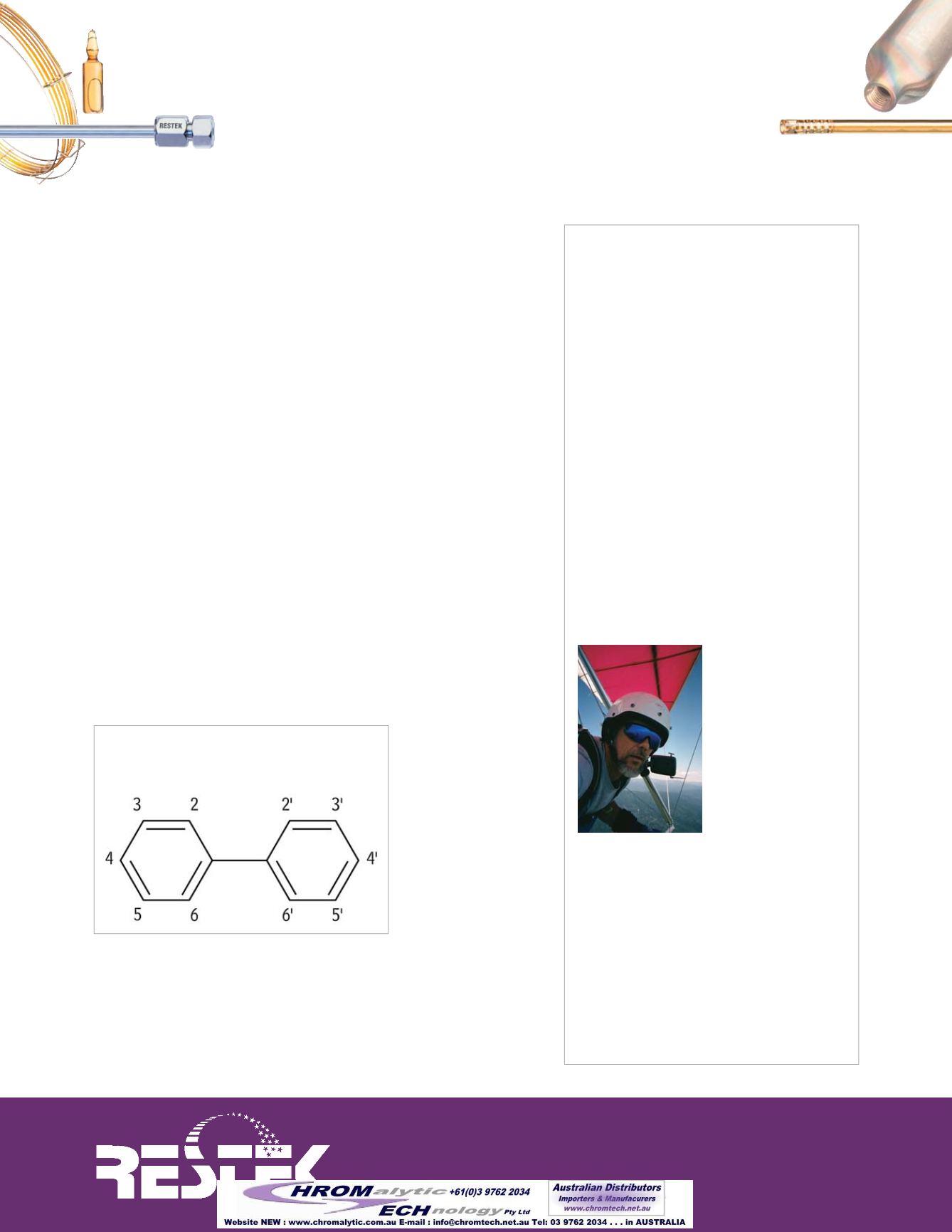

TurningVisions into Reality
™
www.restek.com20
YEARS
THE
RESTEK
ADVANTAGE
Turning Visions into Reality
™
2005
vol. 2
in this issue
Rtx®-PCB: Unique Selectivity for PCBs . . . . . . . . . . . . . . .
1
Accurately Monitor Mercury-Sulfur-Nitrogen
Compounds . . . . . . . . . . . . . . . . . . . . . . . . . . . . . . . . . . . . . .
3
Identify and Quantify Adulterants in Seized Cocaine . .
4
New HPLC Confirmation Column for
Explosives Analysis . . . . . . . . . . . . . . . . . . . . . . . . . . . . . . . .
6
Analytical Reference Materials . . . . . . . . . . . . . . . . . . . . .
7
Excellent Protein Separations from
Viva™ HPLC Columns . . . . . . . . . . . . . . . . . . . . . . . . . . . . . .
8
Survival Kits for HPLC . . . . . . . . . . . . . . . . . . . . . . . . . . . . . .
9
Improve Storage Stability for Sulfur Compounds . . .
10
Analysis of Nitrofurans in Honey . . . . . . . . . . . . . . . . . .
11
FID Gas Stations: FID-1000 & New FID-2500 . . . . . . . .
12
Volatile Organic Compounds by GC/MS . . . . . . . . . . .
12
Instrument Innovations . . . . . . . . . . . . . . . . . . . . . . . . . .
14
Cool Tools . . . . . . . . . . . . . . . . . . . . . . . . . . . . . . . . . . . . . . .
15
Items of Interest . . . . . . . . . . . . . . . . . . . . . . . . . . . . . . . . .
16
Restek Goes West!
Restek celebrates contin-
ued growth in 2005 with
the opening of Restek
West, our new R&D facili-
ty in Shingle Springs,
California. Roy Lautamo,
Director of Innovative
Research Chemistries, will
manage the facility,
focusing on R&D for our
chromatography column
product lines. Roy has an
extensive range of experi-
ence in chromatography,
acquired over more than
a quarter of a century of
research.
We welcome Roy and his staff into the Restek family!
Correction
In
Advantage
2005v1:
Fast GC/MS Analysis of
Semivolatile Organic Compounds
, Figure 1 (page 14) the
splitless hold time and pressure pulse time are
reversed. The splitless hold time should be 0.15 min.
and the pressure pulse time should be 0.20 min. We
apologize for any inconvenience caused by this error.
Rtx®-PCB: Unique Selectivity for PCBs
110 of 158 target PCB Congeners Elute
Individually, Using GC/ECD
by Gary Stidsen, GC Columns Marketing Manager
• NEW low polarity, inert polymer phase provides distinct separations
of PCB congeners.
• Unmatched selectivity and low bleed—a column of choice for trace
analysis.
• Thermally stable to 340ºC.
Rtx®-PCB columns show unique selectivity for polychlorinated biphenyl
(PCB) congeners. In previous publications (lit.# 59925 and Advantage
2005v1, lit.# 59077, page 13), we discussed the excellent performance of this
column and showed each of the European PCB congener indicator com-
pounds - PCBs 28, 52, 101, 118, 138, 153, and 180 - can be resolved from other,
interfering PCB congeners and quantified, using GC/MS.
“Weathering” of Aroclor® mixes that have been in the environment for more
than 30 years, and changes in Aroclor® patterns in tissue samples, due to
bioaccumulation, have dictated that PCBs now be reported as congeners,
rather than as Aroclor® mixes. Consequently, many laboratories are analyzing
longer lists of PCB congeners, using the data in determining specific congener
patterns, in compiling congener results to obtain an accurate total PCB con-
centration, and in other ways.
The structure of the
biphenyl molecule is
shown in Figure 1.
Identification
and
quantification of PCB
congeners is chromato-
graphically challenging
because there are 209
possible combinations
in which chlorine
atoms can be added to
the biphenyl structure,
ranging from addition
of a single chlorine (monochlorobiphenyls) to addition at every available car-
bon atom (decachlorobiphenyl). In 1996, George Frame published work he
performed in order to determine which PCB congeners are present in
Aroclor® mixes.¹ Using this work as a guide, the list of 209 possible PCB con-
geners can be reduced to a target list of 158 congeners. This final target list
includes PCB congeners found in Aroclor® mixes above 0.01%wt/wt, and a
few compounds not detected in Aroclor® mixes, but detected in tissue due to
Figure 1
Biphenyl structure supports 209
PCB congeners, many with very similar
retention characteristics.
Roy Lautamo gliding
over Kings Canyon in
the southern Sierra.


















